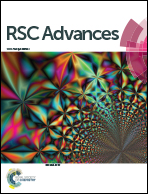Prediction of 1H NMR chemical shifts for ionic liquids: strategy and application of a relative reference standard†
Abstract
The computational predictions of 1H NMR chemical shifts for ionic liquids were investigated. To calculate the chemical shifts more accurately, the approach of relative reference standard (RRS) was proposed. This straightforward computational technique uses organic compounds and ionic liquids that are similar to the studied ionic liquids as standards. The calculated chemical shifts of single ion pairs were strongly influenced by the anion type and the local environment. Using the RRS methodology, the calculated results agreed well with the experimental chemical shifts due to the cancellation of errors caused by the anion. Ionic clusters consisting of 4 ion pairs were also employed to model the ionic liquids with strongly coordinating anions. Large clusters slightly improve the accuracy by reducing systematic errors. Although the experimental 1H NMR data of the reference ionic liquid should be used, the RRS methodology has been shown to predict 1H NMR chemical shifts efficiently at different levels of theory.



 Please wait while we load your content...
Please wait while we load your content...